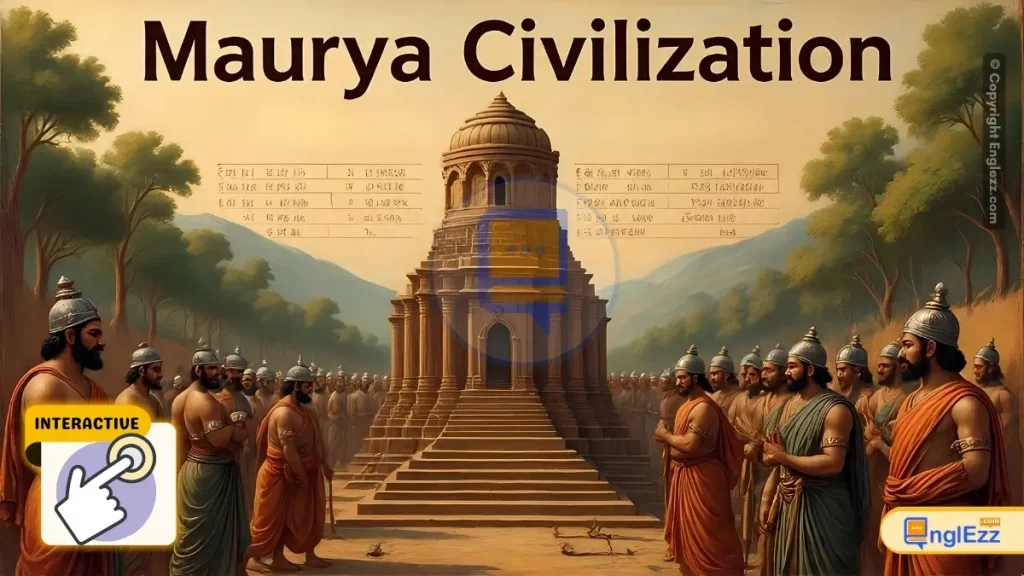
The Story of Maurya Civilization Empire
From Chandragupta to Ashoka – India’s First Empire
Introduction
The Mauryan Journey
The Maurya Empire (322-185 BCE) was the first pan-Indian empire in South Asian history, covering most of the Indian subcontinent. Founded by Chandragupta Maurya with the guidance of his mentor Chanakya, the empire reached its zenith under Emperor Ashoka, who converted to Buddhism after the bloody Kalinga War.
The Mauryan Empire was known for its sophisticated administration, extensive trade networks, and remarkable public works. The Arthashastra, a treatise on statecraft attributed to Chanakya, provides detailed insights into Mauryan governance. The empire also saw advancements in art, architecture, and urban planning, with the Ashokan pillars being particularly notable.
Foundation
The early Mauryan period (322-268 BCE) saw the empire’s establishment under Chandragupta Maurya, who defeated the Nanda dynasty and the Greek satraps left by Alexander. Chandragupta created a centralized administration and expanded the empire’s borders through military conquests and strategic alliances.
Ashoka’s Reign
The peak period (268-232 BCE) under Emperor Ashoka saw the empire reach its greatest territorial extent. After his conversion to Buddhism following the Kalinga War, Ashoka promoted dharma (moral law) and established numerous stupas and pillars with edicts promoting non-violence, tolerance, and welfare.
Historical Legacy
The Mauryan Empire’s legacy endured long after its decline. Its administrative systems influenced later Indian empires, while Ashoka’s conversion to Buddhism helped spread the religion across Asia. The empire’s art and architecture, particularly the Ashokan pillars, remain iconic symbols of ancient India’s achievements.
Interactive Maurya Empire Timeline
Chandragupta Maurya Founds the Empire
Chandragupta Maurya, with the guidance of Chanakya, overthrows the Nanda dynasty and establishes the Maurya Empire.
Read moreIn 322 BCE, Chandragupta Maurya, with the strategic guidance of his mentor Chanakya (also known as Kautilya), overthrew the last Nanda ruler Dhana Nanda to establish the Maurya Empire. This marked the beginning of the first pan-Indian empire in South Asian history.
Key aspects of Chandragupta’s rise:
- Utilized a combination of military force and diplomatic strategies
- Defeated the Greek satraps (governors) left by Alexander the Great in northwest India
- Established a centralized administration with Pataliputra as the capital
- Created a vast empire stretching from Bengal to Afghanistan
Chanakya’s political treatise, the Arthashastra, is believed to have guided Chandragupta’s governance. The text covers statecraft, economic policy, and military strategy, revealing the sophistication of Mauryan administration.
Further Reading
- Mookerji, Radhakumud. Chandragupta Maurya and His Times (1966)
- Boesche, Roger. The First Great Political Realist: Kautilya and His Arthashastra (2002)
Treaty with Seleucus I
Chandragupta defeats Seleucus I Nicator and establishes a treaty that cedes territory and establishes diplomatic relations.
Read moreIn 305 BCE, Chandragupta Maurya fought against Seleucus I Nicator, one of Alexander the Great’s generals who had established the Seleucid Empire. The conflict resulted in a decisive Mauryan victory and led to a treaty with significant consequences:
- Seleucus ceded territories including Arachosia (modern Kandahar) and Gedrosia (Balochistan) to Chandragupta
- Chandragupta gave Seleucus 500 war elephants, which played a crucial role in Seleucus’s subsequent victories
- The treaty established diplomatic relations, with Seleucus sending Megasthenes as an ambassador to the Mauryan court
- This marked the Mauryan Empire’s recognition as a major power by Hellenistic kingdoms
Megasthenes’ account, Indika, though now lost, provides valuable information about Mauryan society through references in other classical works.
Further Reading
- Kosmin, Paul J. The Land of the Elephant Kings: Space, Territory, and Ideology in the Seleucid Empire (2014)
- Thapar, Romila. Early India: From the Origins to AD 1300 (2002)
Ashoka Ascends the Throne
Ashoka becomes emperor after a succession struggle, beginning one of the most remarkable reigns in Indian history.
Read moreAshoka’s accession to the throne in 268 BCE followed a period of succession disputes after the death of his father Bindusara. According to Buddhist sources, Ashoka killed his brothers to secure power, though historical accuracy of these accounts is debated.
Early in his reign, Ashoka continued the expansionist policies of his predecessors:
- Consolidated control over the empire inherited from his father
- Expanded Mauryan territories through military campaigns
- Maintained the sophisticated administrative system established by Chandragupta
- Continued diplomatic relations with Hellenistic kingdoms
Ashoka’s early reign was characterized by the same militaristic approach as his predecessors, before his dramatic transformation after the Kalinga War.
Further Reading
- Thapar, Romila. Ashoka and the Decline of the Mauryas (1961)
- Singh, Upinder. Political Violence in Ancient India (2017)
Kalinga War and Ashoka’s Conversion
The bloody conquest of Kalinga leads to Ashoka’s embrace of Buddhism and his policy of dharma.
Read moreThe Kalinga War (c. 260 BCE) was a turning point in Ashoka’s reign and in the history of the Mauryan Empire. The conquest of Kalinga (modern Odisha) was exceptionally brutal, with Ashoka’s own inscriptions describing the massive casualties and suffering.
The war’s aftermath led to:
- Ashoka’s profound remorse and rejection of violence
- His conversion to Buddhism and adoption of dharma (moral law) as state policy
- The issuance of rock and pillar edicts throughout the empire promoting Buddhist values
- A shift from military expansion to welfare and moral governance
Ashoka’s edicts represent the earliest decipherable written records in India after the Indus Valley script. They provide invaluable insights into Mauryan governance and Ashoka’s philosophy.
Further Reading
- Strong, John S. The Legend of King Aśoka: A Study and Translation of the Aśokāvadāna (1983)
- Dhammika, S. The Edicts of King Ashoka (1993)
Death of Ashoka
Ashoka dies after a 36-year reign, and the empire begins to decline under weaker successors.
Read moreAfter Ashoka’s death in 232 BCE, the Mauryan Empire entered a period of gradual decline that lasted about 50 years until its final collapse. The reasons for this decline were multifaceted:
- Weak successors: Later Mauryan rulers lacked the administrative and military capabilities of Ashoka
- Financial strain: The empire’s vast welfare programs and loss of revenue from military conquests
- Administrative decentralization: Growing autonomy of provincial governors
- External pressures: Invasions and incursions from the northwest
- Economic factors: Possible disruption of trade networks and agricultural productivity
The last Mauryan ruler, Brihadratha, was assassinated by his general Pushyamitra Shunga in 185 BCE, marking the official end of the empire and the beginning of the Shunga dynasty.
Further Reading
- Thapar, Romila. Ashoka and the Decline of the Mauryas (1961)
- Sircar, D.C. Inscriptions of Ashoka (1975)
Rediscovery of Ashokan Edicts
James Prinsep deciphers Brahmi script, enabling the reading of Ashoka’s inscriptions and revival of knowledge about the Mauryas.
Read moreIn the 1830s, British scholar James Prinsep successfully deciphered the Brahmi script, which had been used for Ashoka’s edicts. This breakthrough allowed historians to read the inscriptions for the first time in centuries and revolutionized understanding of ancient Indian history.
The rediscovery was significant because:
- It confirmed the existence of the Mauryan Empire and Emperor Ashoka
- Provided direct evidence of Mauryan governance and policies
- Revealed Ashoka’s unique approach to kingship and moral governance
- Stimulated further archaeological research into ancient Indian civilizations
Prinsep’s work, along with subsequent archaeological discoveries, helped establish the Mauryan Empire’s place as a foundational period in Indian history and Ashoka as one of history’s most remarkable rulers.
Further Reading
- Allen, Charles. Ashoka: The Search for India’s Lost Emperor (2012)
- Keay, John. India: A History (2000)
Maurya civilization Quiz
Test Your Knowledge of Mauryan History
Frequently Asked Questions
Common Questions About Maurya Civilization
At its height under Ashoka (c. 250 BCE), the Mauryan Empire was one of the largest empires in the ancient world, covering almost the entire Indian subcontinent except the southern tip. Its territory included:
- Present-day India (except extreme south)
- Pakistan
- Bangladesh
- Nepal
- Parts of Afghanistan
The empire stretched from the Hindu Kush mountains in the northwest to Bengal in the east, and as far south as Karnataka. Estimates suggest it covered about 5 million square kilometers, with a population possibly exceeding 50 million people.
The Mauryan Empire had a sophisticated administrative system described in the Arthashastra and evidenced by Ashoka’s edicts. Key features included:
- Centralized government: With the emperor at the top, assisted by a council of ministers
- Provincial administration: The empire was divided into provinces (like Taxila, Ujjain) governed by royal princes or trusted officials
- District administration: Further divided into districts with their own officials
- Village governance: Local affairs managed by village headmen and councils
- Specialized departments: For revenue, military, trade, espionage, and public works
- Spy network: Extensive intelligence system to monitor officials and populace
The empire maintained a large standing army and developed an extensive road network for administration and trade.
Ashoka’s conversion to Buddhism after the Kalinga War had profound effects on the religion’s development:
- Spread of Buddhism: Sent missionaries throughout India and to Sri Lanka, Central Asia, and Southeast Asia
- Third Buddhist Council: Convened at Pataliputra to purify the Buddhist sangha (community)
- Monument construction: Built thousands of stupas (Buddhist reliquaries) and viharas (monasteries)
- Pillar edicts: Spread Buddhist teachings through inscriptions across the empire
- Moral governance: Implemented Buddhist principles in administration, promoting non-violence and welfare
- Symbolism: The Ashokan lion capital became an important Buddhist symbol, now India’s national emblem
Ashoka’s patronage helped transform Buddhism from a minor Indian sect to a major world religion.
The Mauryan Empire declined over about 50 years after Ashoka’s death (232-185 BCE) due to multiple factors:
- Weak successors: Later rulers lacked the capability to maintain the vast empire
- Financial strain: Ashoka’s welfare programs and loss of revenue from military conquests
- Administrative overextension: Difficulty governing such a large territory
- Provincial revolts: Growing independence of regional governors
- External threats: Invasions from the northwest by Bactrian Greeks
- Economic factors: Possible decline in trade and agricultural productivity
- Military weakening: Ashoka’s pacifist policies may have reduced military readiness
The empire finally ended in 185 BCE when the last Mauryan ruler Brihadratha was assassinated by his general Pushyamitra Shunga, who founded the Shunga dynasty.
Conclusion
The Mauryan Legacy
The Maurya Empire represents a foundational period in Indian history, establishing the first pan-Indian political unity and creating administrative systems that influenced subsequent empires. From Chandragupta’s military conquests to Ashoka’s moral governance, the Mauryans demonstrated remarkable political and cultural achievements.
While the empire lasted only about 140 years, its impact endured for millennia. Ashoka’s pillars and edicts remain powerful symbols of India’s ancient heritage, and the Arthashastra continues to be studied for its insights into statecraft. The Mauryan period also marked a significant phase in the development and spread of Buddhism across Asia.
Maurya Civilization Key Takeaways
Foundation
Chandragupta Maurya established India’s first empire through military conquest and strategic alliances, with guidance from Chanakya’s political wisdom.
Ashoka’s Reign
Ashoka’s transformation after the Kalinga War led to unprecedented policies of moral governance and the spread of Buddhist principles across Asia.
Administrative Brilliance
The Mauryans developed sophisticated systems of governance, economy, and military organization that influenced later Indian states.
Cultural Legacy
Mauryan art and architecture, particularly the Ashokan pillars, became enduring symbols of India’s ancient heritage and identity.
The study of the Maurya Empire reveals not only the achievements of ancient India but also timeless questions about power, governance, and the relationship between state and morality. From Chandragupta’s realpolitik to Ashoka’s ethical revolution, the Mauryan experience continues to offer valuable insights for our understanding of history and political philosophy.
Recommended Reading About Maurya Empire
- Thapar, Romila. Ashoka and the Decline of the Mauryas (1961)
- Mookerji, Radhakumud. Chandragupta Maurya and His Times (1966)
- Sircar, D.C. Inscriptions of Ashoka (1975)
- Boesche, Roger. The First Great Political Realist: Kautilya and His Arthashastra (2002)
- Allen, Charles. Ashoka: The Search for India’s Lost Emperor (2012)










Discover the Interactive Maurya Civilization Timeline Map and embark on a journey through India’s first pan-Indian empire’s pivotal moments in history!